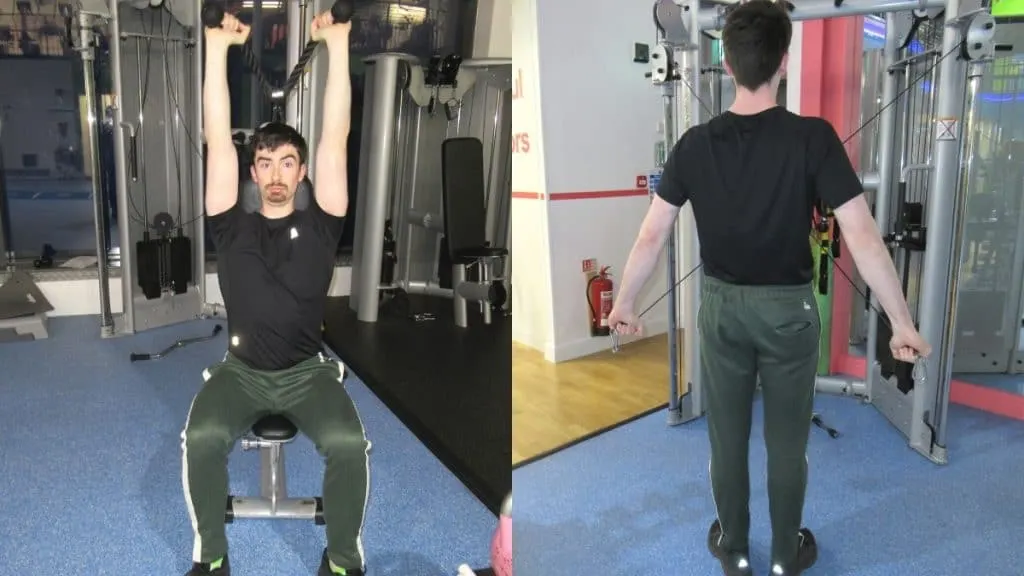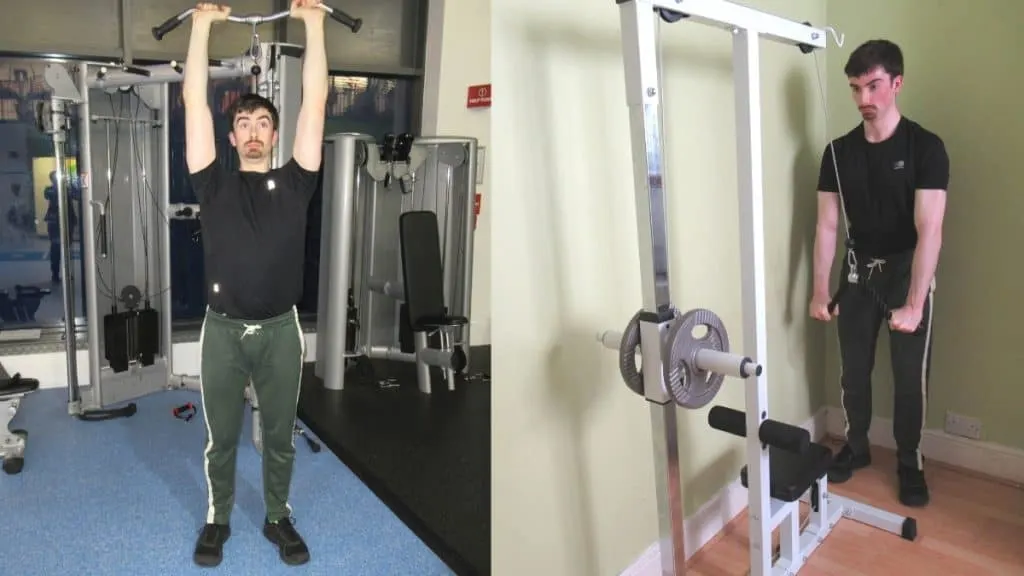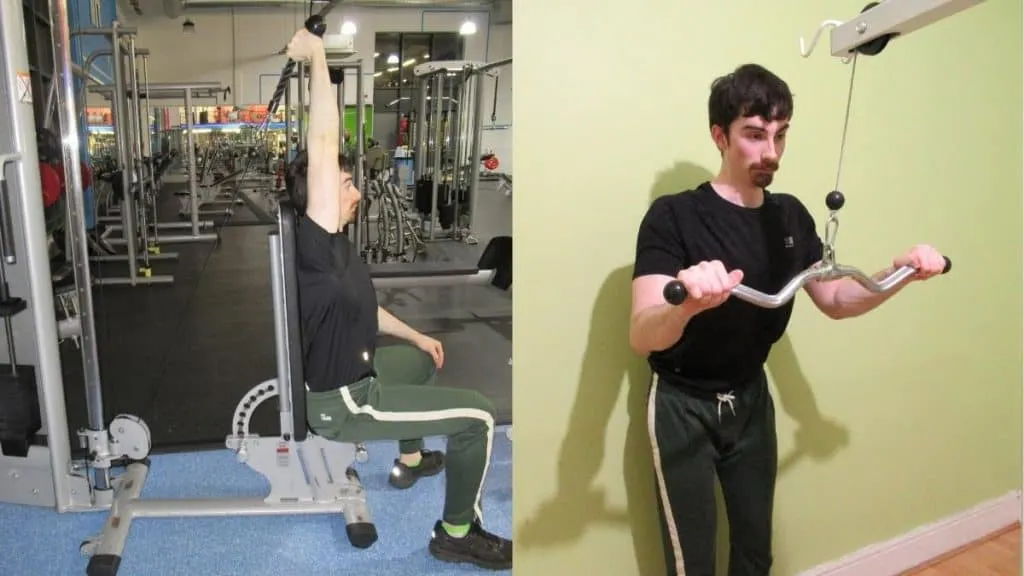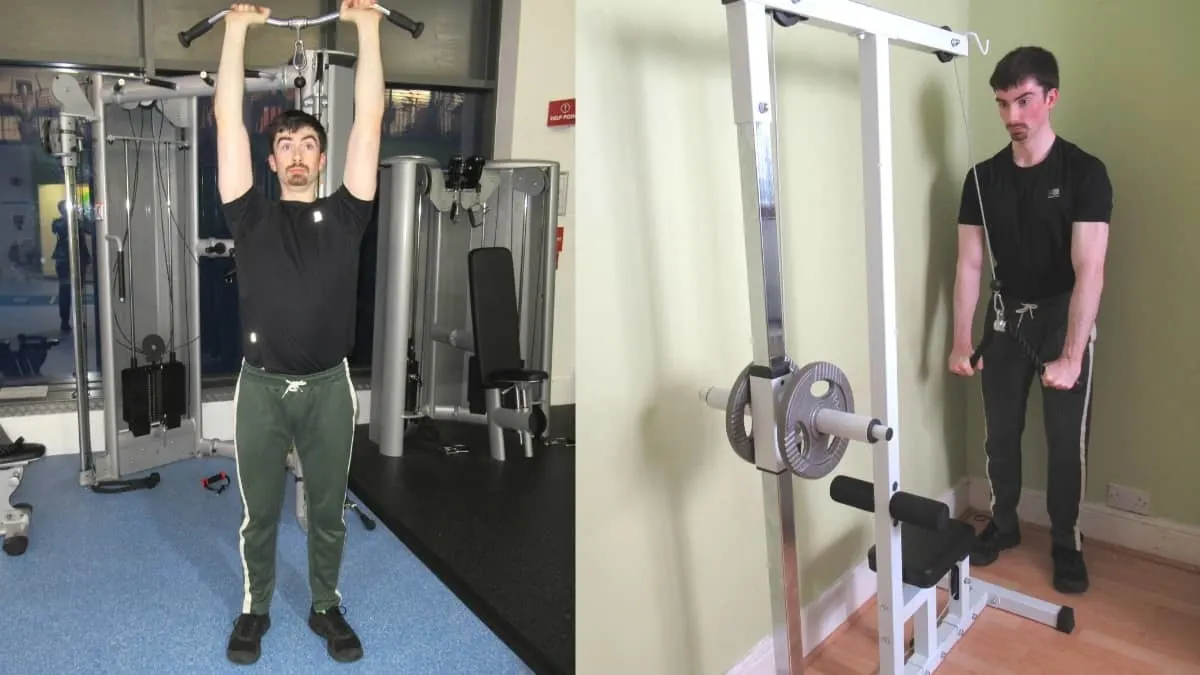Understanding how the triceps brachii functions helps you to get better results in the gym. For example, knowing that only the largest head of the triceps, namely, the long head, crosses the shoulder joint, it’s logical to assume that you need to put your shoulders into flexion in order to maximize your triceps development.
In practice, maximizing your triceps hypertrophy means performing an overhead rope extension or something substantially similar.
But this doesn’t mean that pushdowns don’t have their place. Pushdowns are, in fact, one of the all-time greatest tricep exercises.
This detailed tricep pushdowns vs overhead extensions comparison pits two of the most formidable tricep-builders head-to-head. Keep reading to learn all the differences and to find out whether you need to do both exercises.
Related: Cable tricep extension vs skull crusher
Tricep extension vs pushdown: Summary of the differences
- Tricep extensions stimulate the long head more than pushdowns because they put your shoulders in flexion (which stretches the long head).
- Overhead extensions put more stress on the elbows and shoulders than pushdowns but are generally very safe when performed correctly.
- You’ll likely be able to lift a bit heavier on pushdowns (especially if you lean into the movement).
- Pushdowns are hardest when your elbows are close to full extension, whereas extensions are most challenging when your triceps are stretched (i.e., when you’re elbows are bent and thus in flexion).
Are tricep pressdowns the same as tricep extensions?

Since the primary function of the triceps is elbow extension, the term tricep extension can refer to pretty much any tricep exercise.
And that’s where the confusion starts.
Many people use the terms pushdown and extension interchangeably to describe the same exercise (i.e., a tricep pressdown performed from a high pulley).
Yet, in most resistance training circles, extension is synonymous with either lying extension or overhead extension.
From our observation, the more advanced someone is in terms of physique and strength development, the more likely they are to mean overhead or lying extensions when they use the term tricep extension.
Conversely, if someone is relatively new to lifting weights, then they often just describe the motion of the exercises. And since all tricep isolation exercises are by definition also elbow extension exercises, novice lifters often just call any and every movement a tricep extension.
Rope pushdown vs tricep extension: Hypertrophy and muscle activation

As mentioned at the start of this tricep extension vs pushdown comparison, only the long head of the triceps (which happens to be the biggest tricep head) crosses the shoulder joint.
As such, in order to maximize your triceps development, you need to place your shoulders into flexion so that you can put the crucial long head under a growth-stimulating stretch.
While pushdowns can certainly build muscle, they don’t put your triceps under a particularly deep stretch. In fact, peak tension during a pushdown occurs just before your elbows reach full extension, which naturally means that pushdowns produce a stronger peak contraction than extensions.
Tricep extensions, on the other hand, are hardest toward the bottom of the rep when you have to lift the bar or cable attachment “out of the hole.” Once you lock your elbows out, there’s virtually no tension on your triceps during an extension, especially if you’re using free weights (cables still produce some tension when your elbows are locked out).
So in terms of muscle activation and peak tension, tricep extensions and tricep pushdowns are, if not complete opposites, drastically different at the very least.
As for hypertrophy, tricep extensions are the better choice because they train all three tricep heads while giving extra emphasis to the biggest of these heads (the long head contributes more mass to the triceps than the medial and lateral heads combined).
Tricep extension vs tricep pushdown: Strength development

As noted in the summary section of this tricep pushdown vs extension comparison, most people can lift more weight on pushdowns than extensions. This is because, like a compound press, pushdowns train your triceps in the position in which your triceps are at their strongest.
When you put your shoulders into flexion, and especially into extension, the triceps can’t produce as much force because the muscle is either really stretched or really contracted.
When you do pushdowns, on the other hand, the lateral head is more active, which, although smaller than the long head in terms of size, is often thought to be the strongest tricep head.
Additionally, many people tend to lean forward during pushdowns and bring their chest into the movement, which in turn enables them to lift more weight. This is obviously a mistake that you should seek to avoid because the whole point of a pressdown is to keep the tension on your triceps.
Although you might be able to lift a bit more weight on pushdowns, both exercises are equally good for gaining strength because cable weight stacks typically increase in very manageable increments. Thus, both extensions and pushdowns are highly conducive to progressive overload.
Now, if we’re talking about long head strength, then extensions are the better choice because they place more tension on the long head than pushdowns (and any other exercise, for that matter).
Should you include both exercises in your workout routine?

There’s no need to choose either the tricep pushdown or overhead extensions; you can do both exercises.
Since they train your triceps from different angles and exert their peak tension during different phases of the rep, it makes sense to do extensions and pushdowns if you’re in pursuit of maximum triceps hypertrophy.
Since rope pushdowns and extensions are both cable exercises, they also put less pressure on your joints than free-weight equivalents. This means that your elbows can tolerate more sets of press downs and overhead extensions than they can sets of skull crushers, for example (see our skull crushers vs tricep pushdowns comparison for more info).
Should you do rope pushdowns or tricep extensions first?

In most cases, you should do tricep extensions before rope pushdowns.
Extensions train the long head more optimally than pushdowns and are therefore more essential for gaining overall triceps mass.
Rope pushdowns, much more so than straight bar pushdowns, produce an intense peak contraction because you can “split” the rope at the end of the rep to make your triceps work harder. As such, pushdowns are a great cable tricep extension alternative and are also a tremendous high-rep finishing exercise to do toward the latter end of your workout.
You can, of course, do both press downs and extensions, but on different days of the week. This twice-weekly approach is a great way to train your triceps with extra frequency and thus take advantage of more regular muscle protein synthesis spikes.
Read More: Overhead extensions vs dips
Tricep extensions vs pushdowns: The verdict

Pushdowns and extensions are the two titans of tricep training, and both have their place in any resistance training routine.
However, if you can only do one exercise, then definitely go with overhead extensions. Pushdowns, while a fantastic and very safe exercise, aren’t necessary for maximizing triceps growth because they don’t train the long head optimally (the other two heads are worked just fine with heavy compound presses).
Tricep extensions, on the other hand, place the long head under a massive, fiber-tearing muscle stretch during the eccentric phase of the rep, which means that they’re a better choice for stimulating hypertrophy.
I hope that you found our tricep pushdown vs tricep extension comparison useful. Hopefully, it cleared up the differences between the two exercises so that you can program your routine with more precision; while both movements are elbow extension exercises, they work the triceps in very different ways.

